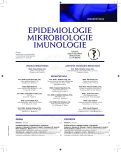The current view of the diagnosis and management of amebiasis in the light of the authors’ own case reports
Authors:
M. Voldřich 1; P. Novotný 1; T. Tyll 1; J. Rudiš 2; T. Belšan 3; D. Hedlová 4; M. Stefanová 5
Authors place of work:
Klinika anesteziologie, resuscitace a intenzivní medicíny, 1. LF UK a Ústřední vojenská nemocnice – Vojenská fakultní
nemocnice Praha
1; Chirurgická klinika, 2. LF UK a Ústřední vojenská nemocnice – Vojenská fakultní nemocnice Praha
2; Radiodiagnostické oddělení, Ústřední vojenská nemocnice – Vojenská fakultní nemocnice Praha
3; Oddělení nemocniční hygieny, Ústřední vojenská nemocnice – Vojenská fakultní nemocnice Praha
4; Interní oddělení Nemocnice Na Františku, Praha
5
Published in the journal:
Epidemiol. Mikrobiol. Imunol. 63, 2014, č. 3, s. 226-231
Category:
Souhrnná sdělení, původní práce, kazuistiky
Summary
This comprehensive review is focused on a serious protozoan disease, amebiasis. This disease is caused by the human parasite Entamoeba histolytica (E. histolytica), the second leading cause of mortality due to protozoan disease worldwide (the leading cause is malaria).
The incidence of amebiasis in the Czech Republic is very low, but it may be underreported as the disease often escapes diagnosis.
Intestinal colonisation by E. histolytica may be asymptomatic. The clinical picture ranges from diarrhea to colitis or fulminant colitis when the parasite progresses to the trophozoite stage. Secondary dissemination in the blood or lymph system may induce systemic signs of the disease. Liver abscess is the most common extraintestinal form of amebiasis.
The diagnosis of intestinal amebiasis is based on the clinical picture and parasitological examination of the stool. To diagnose extraintestinal amebiasis, serology tests are used to detect antibodies in the blood. Recently, molecular methods have been increasingly used for the detection of the nucleic acids of the pathogen in biological specimens.
The first line therapy for amebiasis are 5-nitroimidazole drugs, currently available in the Czech Republic.
However, surgical intervention should also be considered in patients with a severe course of the disease. Included in the review are the case reports of patients with severe concomitant intestinal and extraintestinal amebiasis.
Keywords:
Entamoeba histolytica – amoebiasis – intestinal and extraintestinal amebiasis – liver abscess
Zdroje
1. Čermáková Z, Valenta Z, Voxová B, Roučková V, et al. Entamoeba histolytica – nebezpečný střevní prvok (II. část). Folia Gastroenterol Hepatol, 2008;6(3):108–111.
2. Leder K, Weller PF. Intestinal and extraintestinal Entamoeba histolytica amebiasis. UpToDate [online] 2012-[cit.2012-09-11]. Available from: http://www.uptodate.com/patients/content/topic.do?topicKey=parasite/84-35
3. Ximénez C, Morán P, Rojas L, Valadez A, et al. Novelties on Amoebiasis: A Neglected Tropical Disease. J Glob Infect Dis, 2011;3:166–174.
4. Anzurez LB. Pediatría general. Rev Med Hosp Gen Mex, 2005; 68: 106–114.
5. Rodriguez-Morales AJ (ed.). Current Topics in Tropical Medicine [online]. InTech, 2012, 564 s. [cit. 2014-04-09]. Available from: <http://www.intechopen.com/books/current-topics-in-tropical-medicine>. ISBN 978-953-51-0274-8.
6. Salit IE, Khairnar K, Gough K, Pillai DR. A possible cluster of sexually transmitted Entamoeba histolytica: genetic analysis of a highly virulent strain. Clin Infect Dis, 2009;49:346.
7. Ackers JP, Mirelman D. Progress in reserch on Entamoeba histolytica pathogenesis. Curr Opin Microbiol, 2006;9(4):367–373.
8. Stanley SL, Jr. Protective immunity to amebiasis: new insights and new challenges. J Infec Dis, 2001;184:504.
9. Stejskal F, Nohýnková E. Amébóza. Sanquis, 2003;29:20–24.
10. Salles JM, Salles MJ, Moraes LA, Silva MC. Invasive amebiasis: an update on diagnosis and management. Expert Rev Anti Infect Ther, 2007;5(5):893–901.
11. McGregor A, Brown M, Thway K, Wright SG. Fulminant amoebic colitis following loperamide use. J Travel Med, 2007;14(1):61–62.
12. Fang D, Shu D. Entamoeba histolytica liver abscess. Canadian Medical Association Journal, 2010;16:1758.
13. DiMiceli L. Distinguishing between pathogenic and non-pathogenic species of Entamoeba. Lab Med, 2004;35(10):613–616.
14. Hamzah Z, Petmitr S, Mungthin M, et al. Development of multiplex real-time polymerase chain reaction for detection of Entamoeba histolytica, Entamoeba dispar, and Entamoeba moshkovskii in clinical specimens. Am J Trop Med Hyg, 2010; 83:909.
15. Liang SY, Hsia KT, Chan YH, et al. Evaluation of a new single-tube multiprobe real-time PCR for diagnosis of Entamoeba histolytica and Entamoeba dispar. J Parasitol, 2010;96:793.
16. Fotedar R, Stark D, Beebe N, et al. Laboratory diagnostic techniques for Entamoeba species. Clin Microbiol Rev, 2007;20:511.
17. Stejskal F. Terapie autochtonních parazitárních infekcí. Postgraduální medicína, 2013;8:55.
18. Gonzales ML, Dans LF, Martinez EG. Antiamoebic drugs for treating amoebic colitis. Cochrane Database Syst Rev, 2009.
Štítky
Hygiena a epidemiologie Infekční lékařství MikrobiologieČlánek vyšel v časopise
Epidemiologie, mikrobiologie, imunologie

2014 Číslo 3
- Stillova choroba: vzácné a závažné systémové onemocnění
- Diagnostický algoritmus při podezření na syndrom periodické horečky
- Perorální antivirotika jako vysoce efektivní nástroj prevence hospitalizací kvůli COVID-19 − otázky a odpovědi pro praxi
- Prokalcitonin: marker vhodný pro diagnostiku sepse i hodnocení antimikrobiální léčby
Nejčtenější v tomto čísle
- Současný pohled na diagnostiku a léčbu amébózy ve světle vlastní kazuistické zkušenosti
- Infekce vyvoláné lidskými alfa herpetickými viry
- Enterohemoragické Escherichia coli jako původci průjmu v České republice (1965–2013)
- Výskyt a vlastnosti baktérií Staphylococcus aureus ve vepřovém mase
